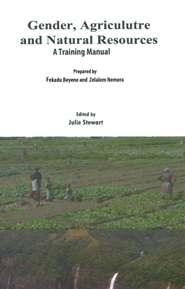
Table Of Contents:
Introduction
Unit 1: Gender Issue and Needs in Agricultural Sector
Unit 2: Gender Responsive Land Tenure in Agricultural Development
Unit 3: Gender, Agricultural Production Extension
Unit 4: Gender and Agricultural Liberalization
Unit 5: Linking Gender, Food security, Nutrition and Agriculture
Unit 6: Soil and Water Managment
Unit 7: Gender in Biodiversity Conservation
Unit 8: Silviculture of Natural and Plantation Forests
Unit 9: Fisheries and Aquatic Resources Managment
Unit 10: Gender in Pastorial Resource Managment
INTRODUCTION
The role of agriculture in contributing to economic development in Africa has been given renewed emphasis. There is a complex interrelationship between agriculture and renewable natural resources. Managing natural resources lays a foundation for the development of agriculture. Understanding the gender dimensions of managing natural resources is crucial in enhancing food security and promoting sustainable rural development. In most African states, women are often active actors in agriculture and natural resource management. Nevertheless, the key role played by women in agricultural development in the past was largely unacknowledged. This situation has changed over the last three decades and much has been achieved in giving recognition to the importance of women in the sector. Yet, there also remain a number of areas where progress in advancing gender equality has not been significant. Though significant progress has been made at political level in empowering women through various interventions, higher learning institutions in Africa do not seem to have a well-developed curriculum on gender with specific links to agriculture and natural resources. The existing curricula are weak on substantive grounds in terms of giving adequate space for African experience and realities. The materials used for teaching are based on western thoughts having little relevance to promoting agricultural development in Africa through analysing and addressing the gendered dimensions of agriculture and environmental management. Postgraduate students who are presumed to be decision-makers in various sectors of the economy need to acquire the necessary knowledge for implementing gender sensitive initiatives in these critical areas for African economies. A teaching manual for a gendered course in Africa needs to be based on African realities that will assist higher institutions to prepare their graduates for successful professional careers. The presence of considerable research outputs and literature on gender in Africa provides a good basis to synthesise and convert them into a teaching package which is linked to agriculture and natural resources. With this in mind OSSREA sought to develop a course for Sub-Saharan Africa Higher Institutions that run Masters of Arts (MA) programs in Gender Studies or related fields of studies. The teaching package synthesises in one place relevant research outputs, experience, and tools which are currently scattered. It thus, provides an up-to-date understanding of gender issues and the complexities linking gender equality, agriculture, and natural resources under a main theme, “Gender, Agriculture and Natural Resources” in the context of Sub-Saharan Africa (SSA). The teaching package has ten main units. Each unit is supported by at least one SSA case. At the beginning of each sub-unit, different brainstorming questions are provided introducing the students to the sub topic.
The first unit, ‘Gender Issues and Needs in Agriculture Sector ‘presents basic concepts and the rationale for integrating gender in agricultural sector and natural resource management.
The second unit, ‘Gender Responsive Land Tenure Development’ covers gender issues in agricultural land tenure security and women’s and men’s rights to land tenure in both formal and customary laws.
The third unit, ‘Gender, Agricultural Production and Extension’, presents gender issues in crop production and extension services. It describes key gender issues such as women farmers’ opportunities and challenges in ccess to extension services, the roles of women in agricultural production and distribution as well as men’s and women’s access to and control over esources.
The fourth unit, ‘Gender Issues in Agricultural Liberalisation’, covers the dynamics of gender in agricultural markets and marketing systems in developing countries with a focus on Sub-Saharan Africa.
The fifth unit, ‘The Interlink of Gender, Food Security, Nutrition and Agriculture’, presents the dimensions of gender in decision-making and access to capital assets, women and food production, influence of gender on gricultural labour utilisation, women and appropriate technology for food production, and the gender dimensions of food and nutritional security.
The sixth unit, ‘Soil and Water Management’, covers theories and practices of soil and water conservation in the light of gender. The roles of women and men in soil and water conservation (watershed and other aspects of ater management) and the impact of soil management and water harvesting in improving gender relations are also presented.
The seventh unit, ‘Biodiversity Conservation’ presents theories and practices related to vegetation inventory analysis and wild life conservation from a gender perspective.
The eighth unit, ‘Silviculture of Natural and Plantation Forest’, covers men’s and women’s access and roles in cultivation and management of forest and plantation trees. The causes and consequences of improper usage f forest products on women and men are also covered.
The ninth unit, ‘Gender and, Fisheries and Aquatic Resource’, presents the theories and practices of aquatic resource management with special focus on the roles of women and men in aquatic resource management.
The last unit, ‘Pastoral Resource Management’, covers theories and practices of rangeland management with specific attention to gender issues in the pastoral setting. The socio-cultural and ecological dimensions of ender in livestock feed management, dairy husbandry, caring for weak and sick animals; violent conflict resolution under the condition when men rarely communicate with women due to cultural barriers; women’s roles in attaining food security by engaging in petty trade are also included.
Make levitra samples work is not sophisticated but still even considering it is also the function that has to be willing to serially.